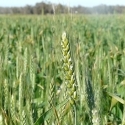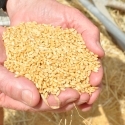16 Feb 2012
P Nutrient Removal and Replacement
Nutrient Removal and Replacement - A strategy for P management
The general strategy for nutrient management is to at least balance input from fertilizers, manures and other sources, with output in produce and any losses. These losses can be to the soil directly to build up background nutrient levels or to the environment as soluble nutrients or nutrient lost through soil erosion.
Monitoring soil fertility with properly calibrated soil tests will help growers identify how much above product removal is required to at least balance estimated removal, but there are quite large differences in seed nutrient content that should be considered.
In 2009, the IPNI collected seed samples from southeastern Australian National Variety Trial field sites, and assessed the nutrient content of those samples. The mean of the grain P contents was 3330 mg/kg (±690 mg/kg) on a dry grain basis, (about 3.0 kg P per kg grain at 10% moisture). This mean value is around 15% higher than the most commonly “estimated” grain P content used in nutrient balances such as the Australian National Land and Water Audit (2001).
Figure 1 Grain P content for wheat taken from 70 sites in southeastern Australia in 2008 and 2009.
Grain P does generally increase with higher soil available P and also decreases with grain yield but in the data set collected, no relationships could be found between grain P and those factors. Also seed P content was not related to seed size.
While the mean value was 3330 mg/kg, that little ± sign tells us that two thirds of the 140 values measured were in the range of 2940 to 4020 – or in statistical terms there was a 20% coefficient of variation in the values. In fact the range was from 1890 to 5000 mg/kg across the whole set.
If growers want to estimate off-take of P in the grain harvested, taking the estimated value of 2900 mg/kg (or 2.6 kg P/t of grain) could under estimate the removal of P by almost 40%.
To help overcome using estimates, get grain P content measured at an ASPAC accredited laboratory so the real value can be obtained. A complementary strategy is to use reliable soil tests to track P over time to see if the test values are changing in response to the current application rates.
P and seed vigour
Marco (1990) and Bolland ad Paynter (1994) identified that wheat seed with lower grain P contents had significantly slower early growth and this effect was consistent even when P was applied to the sown crop. Although critical values for seed P were not reported, it is clear that having higher seed P contents should help improve crop vigour.
Selection of seed from paddocks which have a balanced fertilizer program using adequate P and zinc
is a good way to helping next seasons crop establish quickly.
References
Marco, D. Effect of Seed Weight and Seed Phosphorus and Nitrogen Concentrations in the Early Growth of Wheat Seedlings. Aust. J. Exp. Agric. 1990, 30, 545–549.
Bolland MDA, BH Paynter (1994) Critical phosphorus concentrations for burr medic yellow serradella, subterranean clover and wheat. Comm. Soil Sci. Pl. Anal. 25, 1991-2014.
National Land and Water Resources Audit (2001). Regional Farming Systems and Soil Nutrient Status Final Report September 2001, Land and Water Australia.
Johnson J, and K Syers (2009). A new approach to phosphorus use efficiency in agriculture, Better Crops, 93, 14-16.
http://www.ipni.net/publication/bettercrops.nsf/0/CC9085DA99881B1785257980006F82B4/$FILE/Better%20Crops%202009-3%20p14.pdf
Acknowledgement
Thanks are due to the NVT team for supplying these samples for analysis. A full report on the nutrient levels is available at http://anz.ipni.net/articles/ANZ0073-EN




